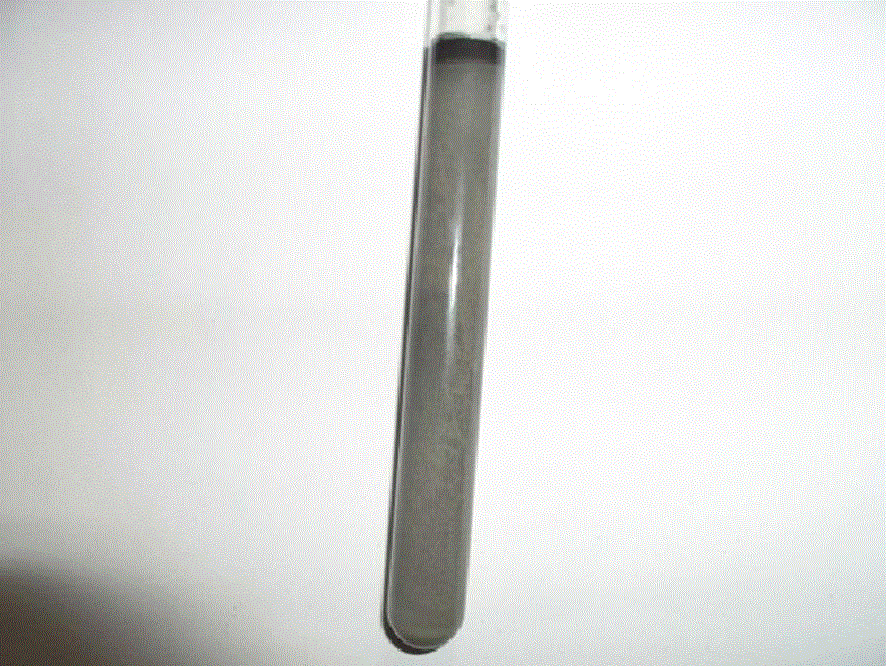C-SiC micro powder separating method
A technology of silicon carbide micropowder and separation method, applied in chemical instruments and methods, solid separation, wet separation, etc., can solve the problems of cumbersome operation steps, consumption, large energy, etc., and achieves cheap and easy-to-obtain raw materials, broad application prospects, The effect of the ideal separation effect
- Summary
- Abstract
- Description
- Claims
- Application Information
AI Technical Summary
Problems solved by technology
Method used
Image
Examples
Embodiment 1
[0026] A method for separating carbon-silicon carbide micropowder, specifically comprising the following steps:
[0027] (1) Measure the density of carbon in the carbon-silicon carbide powder mixture to be 2.2g / cm 3 The method for measuring the density of carbon in the carbon-silicon carbide micropowder mixture is as follows: take the carbon-silicon carbide micropowder mixture of a certain weight, first adopt the pycnometer method to record the density of the mixture, and then burn at high temperature to remove the carbon in the mixture, i.e. The content of silicon carbide and carbon can be obtained, and the density of silicon carbide is 3.2g / cm 3 Calculate, and then calculate the density of carbon;
[0028] (2) Take 10g of carbon-silicon carbide powder mixture and 100g of it with a density of 2.96g / cm 3 The liquid dispersion medium of the two, after mixing the two, fully stir, and let stand for stratification; after stratification, see figure 1 , it can be clearly seen th...
Embodiment 2
[0031] A method for separating carbon-silicon carbide micropowder, specifically comprising the following steps:
[0032] (1) Measure the density of carbon in the carbon-silicon carbide powder mixture to be 2.2g / cm 3 The method for measuring the density of carbon in the carbon-silicon carbide micropowder mixture is as follows: take the carbon-silicon carbide micropowder mixture of a certain weight, first adopt the pycnometer method to record the density of the mixture, and then burn at high temperature to remove the carbon in the mixture, i.e. The content of silicon carbide and carbon can be obtained, and the density of silicon carbide is 3.2g / cm 3 Calculate, and then calculate the density of carbon;
[0033] (2) Take 20g of carbon-silicon carbide powder mixture and 90g of it with a density of 2.96g / cm 3 The liquid dispersion medium of the two is fully stirred after the two are mixed, and left to stand for stratification; the liquid dispersion medium is carbon tetrachloride; ...
Embodiment 3
[0036] A method for separating carbon-silicon carbide micropowder, specifically comprising the following steps:
[0037] (1) Measure the density of carbon in the carbon-silicon carbide powder mixture to be 2.2g / cm 3 The method for measuring the density of carbon in the carbon-silicon carbide micropowder mixture is as follows: take the carbon-silicon carbide micropowder mixture of a certain weight, first adopt the pycnometer method to record the density of the mixture, and then burn at high temperature to remove the carbon in the mixture, i.e. The content of silicon carbide and carbon can be obtained, and the density of silicon carbide is 3.2g / cm 3 Calculate, and then calculate the density of carbon;
[0038] (2) Take 40g of carbon-silicon carbide powder mixture and 100g of it with a density of 2.6g / cm 3 The liquid dispersion medium of the two is fully stirred after the two are mixed, and left to stand for stratification; the liquid dispersion medium is tribromoethane;
[00...
PUM
| Property | Measurement | Unit |
|---|---|---|
| density | aaaaa | aaaaa |
| density | aaaaa | aaaaa |
| density | aaaaa | aaaaa |
Abstract
Description
Claims
Application Information
 Login to View More
Login to View More - R&D
- Intellectual Property
- Life Sciences
- Materials
- Tech Scout
- Unparalleled Data Quality
- Higher Quality Content
- 60% Fewer Hallucinations
Browse by: Latest US Patents, China's latest patents, Technical Efficacy Thesaurus, Application Domain, Technology Topic, Popular Technical Reports.
© 2025 PatSnap. All rights reserved.Legal|Privacy policy|Modern Slavery Act Transparency Statement|Sitemap|About US| Contact US: help@patsnap.com

